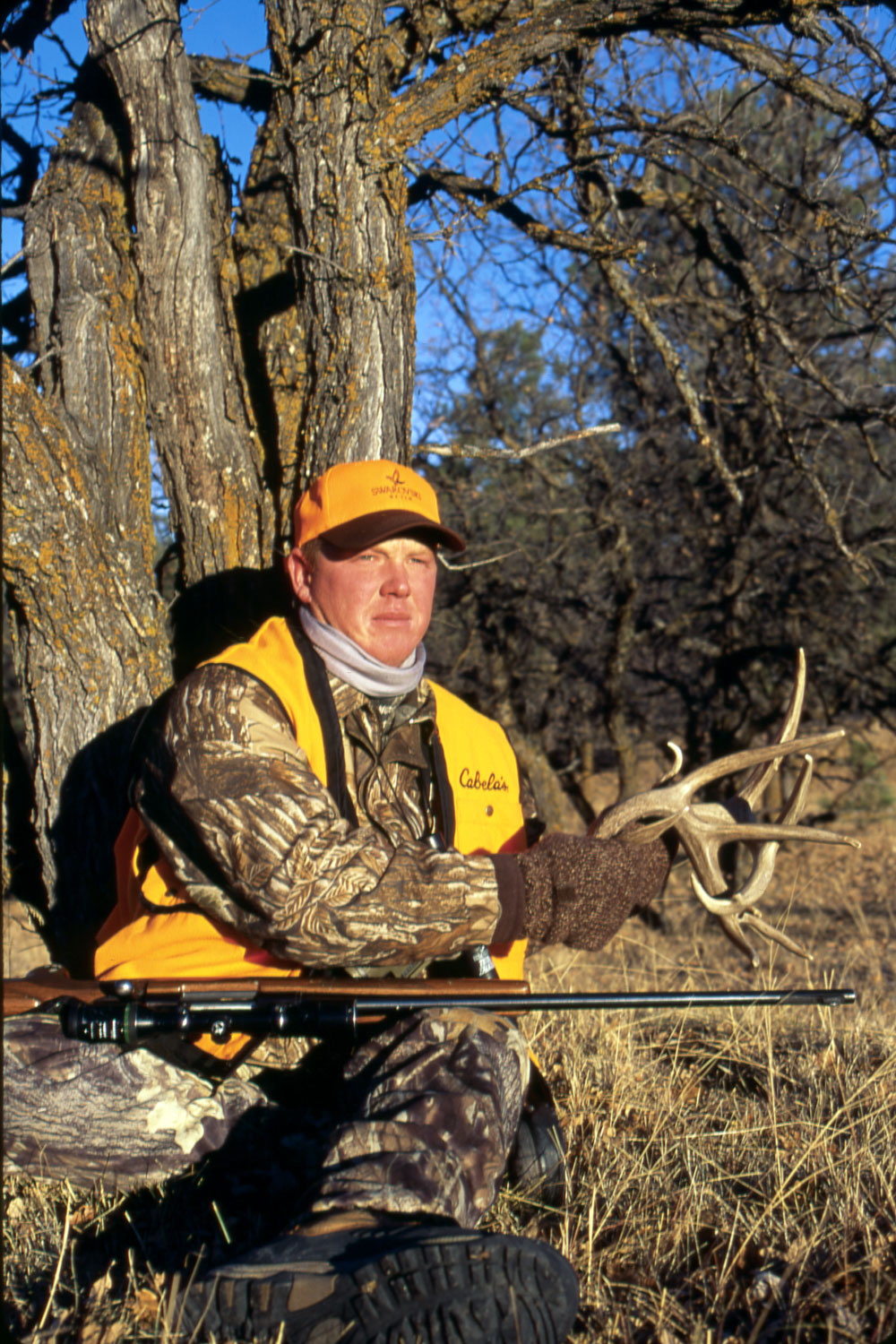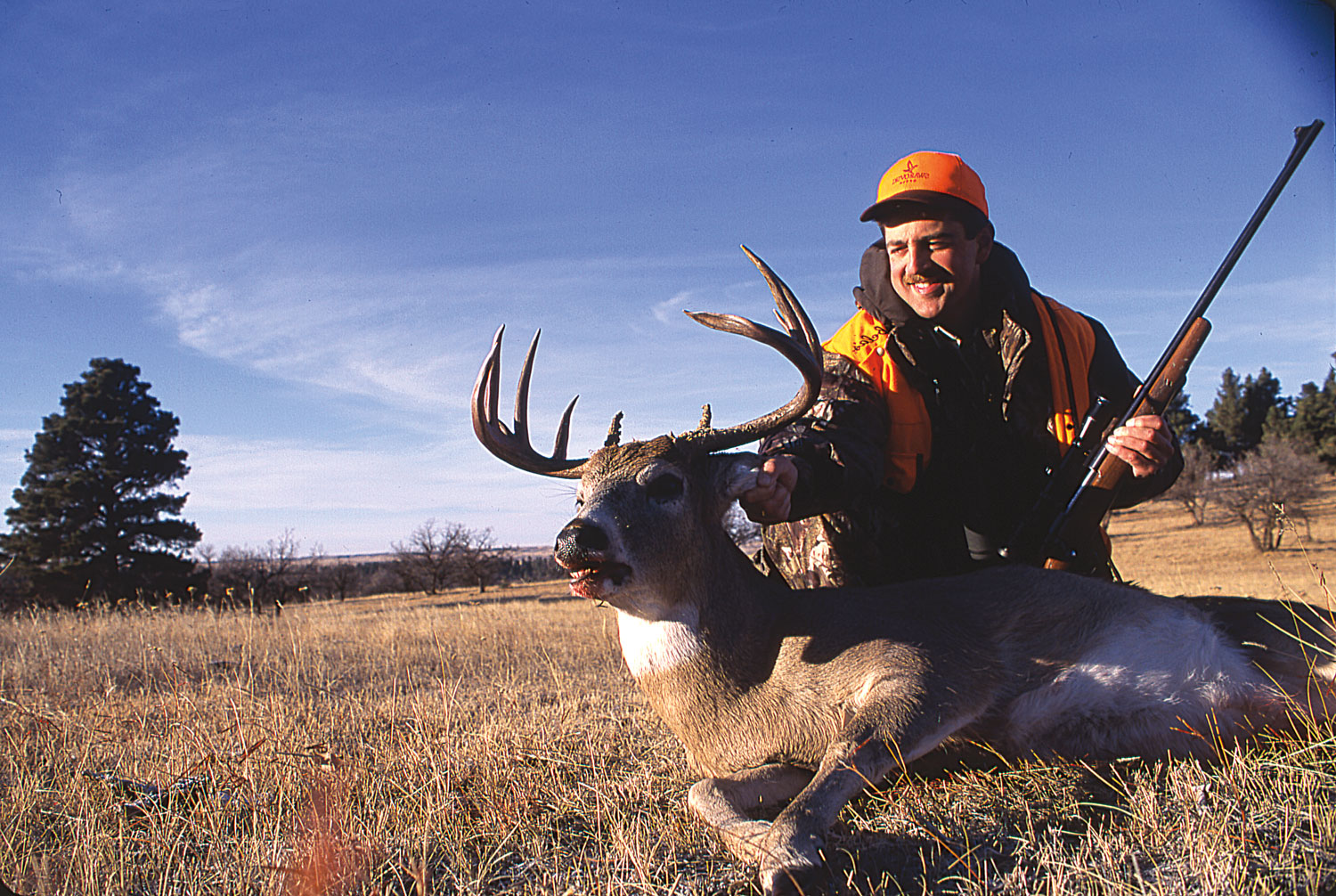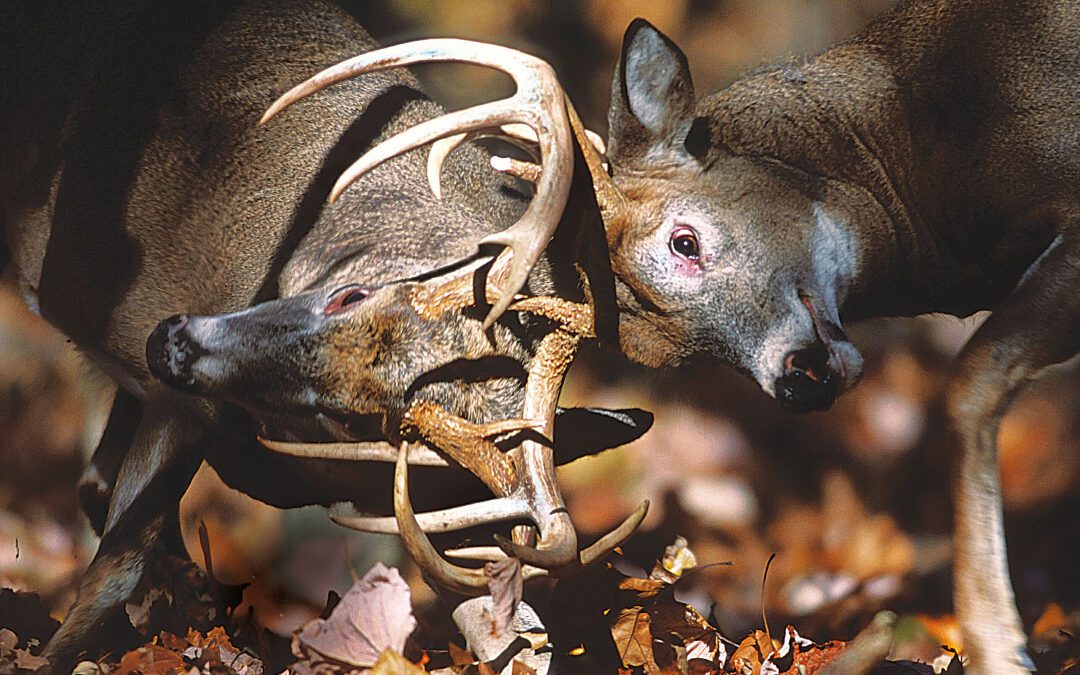First light came to the riverbottom like a developing Polaroid, shades of gray giving way to bright greens and golds with every blink. The barely noticeable form of a distant buck crosses the valley below us in the nose-down manner of a spaniel working the scent trail of a pheasant. For guide Jimmy Bailey, it is a good sign that the rut has commenced in earnest after a couple of weeks of false starts.
“Let’s wait till we have a little more light,” he says to me in a hushed tone, “then we can walk the ridges and try some rattling.”
Soon we are wandering upslope over the scrub oak and pine hills that roll across this part of eastern Wyoming. The sprawling ranch conjures scenes of wagon trains and war parties. The rugged character of the landscape looks like the habitat of the Marlboro man—and it should, for many of the dramatic vistas portrayed in those ad campaigns were indeed photographed in this very valley.
Halfway up the ridge where Bailey wants to try his luck at rattling, we spy a trio of does milling on the edge of a cedar thicket. The partial form of a deer behind the does finally emerges from the evergreen curtain, revealing a handsome eight-point buck. A lesser whitetail also steps into view and the group bounds off, stopping frequently to look back in a manner more characteristic of mule deer.
To the west, I catch a faint outline of another deer gliding through the oaks perhaps 200 yards distant of us. I focus my binoculars ahead of the movement, in an opening about a deer-length wide. In a moment I catch the unmistakable gleam of early morning light reflecting off antler as the buck steps quickly through my field of view, the event having the same effect on me that a glinting four-carat diamond might have on a debutante. The buck disappears over the rise, however, so we continue our trek to the crest.
We reach a saddle of land between two valleys, and Bailey surveys the real estate, pausing to determine the most likely direction from which a buck might approach. Once he calculates the odds of such, he looks for a bit of cover—a tree stump or shrub perhaps—while he positions us with the wind and sun in our favor. I lean against the base of a pine as Bailey arms himself with a pair of antlers and a grunt tube. Soon the clashing sound from his antlers is reverberating down the canyons below.
While I’ve enjoyed some success by rattling in sequence for 20 to 30 seconds at a time, Bailey’s recital lasts well more than a minute. He mixes grunts with incessant rattling, seemingly to broadcast a pair of fighting bucks. He often grunts between rattling sequences, just long enough to make sure they are heard over the din of the smacking antlers. It’s a subtle but perceptible difference from the rattling I’ve heard by many other hunters and guides.

I scan an opening about 100 yards across as Bailey focuses on the areas that I cannot see. One of the intriguing aspects of rattling and grunting—like any game calling—is that you’re never quite certain from where a buck might appear, though mature bucks usually approach downwind of your rattling, cautiously investigating before blundering into a confrontation.
In the case of rattling, because bucks are familiar with the sound, they often approach with a fixed mental picture of what they’re going to see. This phenomenon explains why many approaching bucks don’t react immediately to a hunter’s presence. It’s as if the deer is so convinced by what it’s hearing that it cannot quickly reconcile the difference in what it’s seeing—especially if the wind doesn’t deliver proof through scent.
“You can usually get away with a little movement,” says Bailey, “but if a buck sneaks in and you don’t see him right away, he’ll have enough time to study you and disappear before you even knew he was there.”
As I fixate on the opening ahead, Bailey leans forward and prods me in the shoulder with one of the antlers. I look left and spy a doe and fawn that have silently materialized from a thicket of scrub oaks. They have come to investigate Bailey’s ventriloquist act, but they seem confused when they do not encounter any bucks.
Suddenly the deer turn and stare into the cover behind them, ears perked and heads upright and alert. At the same instant I catch the glimpse of a buck running at us, its backlit form casting a larger-than-life shadow that lopes along like a caricature of the living buck. He bolts so quickly that I cannot make out the dimension of his rack until he stops just 40 yards in front of us. He’s a handsome eight-pointer with exceptional brow tines, but he has yet to reach maturity. I am less than two hours into my hunt, so I admire the beast and let him walk away. He is the kind of deer that, given the chance to ripen, will become a buck of legend in these parts.
Bailey has guided for six years in the area with Mike Watkins’ Trophies Plus Outfitters, an operation that now has hunting rights on a vast territory of prime whitetail and mule deer habitat—some 45,000 acres in Wyoming and another 110,000 acres in Montana. Of the dozens of hunters they guide each year, roughly 85 percent are successful, with whitetail bucks averaging 130 inches of antler. This astonishing success can be largely attributed to their disciplined approach to taking bucks. It’s borne out of the simple axiom that you cannot take a trophy animal unless you pass on inferior bucks.

It’s part of the founding philosophy to which Watkins adheres. In the comfortable confines of his lodge, which seems to be continually permeated with the aroma of baking bread and cookies, I listen to him as he explains why he hunts this region and how he does it so successfully.
In essence, it’s a rich landscape for whitetails, mule deer, pronghorn, and even turkeys. The mixture of river bottoms—resplendent with acorn-bearing oaks—and adjacent hayfields serves as a rich environment for growing trophy-quality bucks. Equally impressive is just how savvy his guides are, for they are all veterans of the rattling game and seem to know what a buck is going to do even before it does.
While Wyoming built its big-game reputation primarily on mule deer, elk, and pronghorns, many hunters who used to stalk the state’s mulies are now headed to Wyoming for whitetails. Wyoming’s whitetail herd now numbers about 50,000, but the annual harvest is a mere 8,000 animals. By eastern standards, hunting pressure is extremely light—yet another reason why rattling is so effective.
Although the record books are not littered with entries from Wyoming, the state’s ever-expanding herd is producing trophy animals—bucks in the 150 to 160 class are not uncommon. The largest typical Wyoming whitetail entered in the Boone and Crockett book scored 191 and was taken in 1986. Entries of that caliber will only increase as whitetails continue to pioneer new range across the state.
“We continually see whitetails in areas that used to be exclusively mule deer territory,” says Watkins. “They’re even showing up in areas where I used to guide for elk in the western part of the state.”
With the playing field once again clear, Bailey resumes his rattling exercise. In less than five minutes I again feel a nudge from Bailey and I turn to see another eight-pointer stutter-stepping toward us some 50 yards away. Though not as impressive as the buck that just vacated, this buck also shows great promise—its perfectly symmetrical rack extending nearly as wide as his ears. A slight gust of wind delivers our scent to the buck, and he snorts once before blowing back downslope and out of sight.
I begin to wonder just how many bucks could be holding within earshot of the rattling. As any veteran deer hunter will tell you, you have to have a favorable buck-to-doe ratio in order for rattling to be effective. If there’s too many does in a given area, there isn’t much incentive for a buck to leave them to spar with another buck.
“It’s hard to say for sure, but there’s probably one buck for every four or five does in this area,” Bailey tells me.
Before Bailey has a chance to renew his rattling recital, another buck emerges from the opposite direction of the other two animals. This time it’s a heavy-antlered 11-point, its rack shoe-polish dark from buffing on cedar trees. He is only 40 yards downslope from us as he steps into full view. A ray of early morning sunshine lasers him like a spotlight. He gives me a simple profile shot, and we collect the magnificent 10-point, 150-class buck and ponder how perfectly—how unbelievably—he followed Bailey’s rattling script.
Given the right locale, timing, and technique, there’s no doubting the effectiveness of rattling. And if you’ve never tried it, a new view of deer hunting awaits you . . . one you’ll never forget.

